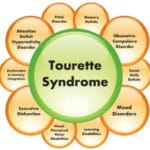Noonan Syndrome doesn’t define these celebrities; their talent, resilience, and advocacy do. From the silver screen to the sports arena, celebrities with Noonan Syndrome are breaking barriers and inspiring millions. These inspiring figures are changing the narrative around Noonan Syndrome, proving that a diagnosis is not a limitation. Discover the untold stories of celebrities who are living proof of the strength and diversity within the Noonan Syndrome community.
Understanding Noonan Syndrome
What is Noonan Syndrome?
Noonan Syndrome (NS) is a genetic disorder present from birth that can affect various parts of the body. It’s a bit like a variation in the body’s blueprint, influencing physical characteristics and development. Commonly, individuals with NS may have distinct facial features, shorter stature, and potential heart-related issues.
How Common is Noonan Syndrome?
NS is estimated to occur in approximately 1 in 1,000 to 2,500 live births. This prevalence underscores the importance of raising awareness. Early diagnosis can significantly improve someone’s quality of life by providing access to essential medical care and resources. This early intervention empowers individuals with NS and their families to navigate the challenges and celebrate the triumphs that come with this condition. Dive into the fascinating world of norium and uncover its hidden secrets.
How is Noonan Syndrome Inherited?
NS can be inherited from a parent or occur spontaneously due to a new genetic mutation. Ongoing research continues to explore the genetic complexities of the condition.
Celebrities and Noonan Syndrome: Representation Matters
Public figures hold a unique position in shaping our understanding of diverse experiences. When a celebrity is thought to have a genetic condition like NS, it raises important questions about visibility and representation. While respecting individual privacy is paramount, the potential impact of such representation is undeniable. If a well-known figure openly shares their journey with NS, it can be immensely powerful. Although confirming a diagnosis without public statements is difficult, online discussions sometimes suggest certain celebrities may have NS. Whether or not these speculations are accurate, seeing successful individuals navigating life with similar challenges can be incredibly inspiring. It reinforces the message that achieving one’s goals is possible, regardless of genetic makeup.
The Power of Seeing Yourself Reflected
Imagine the impact of a young person with NS seeing someone they admire who also likely lives with the same condition. This representation fosters a sense of belonging and can empower individuals with NS to see their potential. It challenges stereotypes and promotes a more inclusive and accepting society. For families, it offers reassurance and strengthens the belief in their child’s abilities.
Responsible Conversations: Respect, Privacy, and Empowerment
Discussions about celebrities and NS require sensitivity. Speculating about someone’s health is never appropriate. Responsible conversations should focus on confirmed information and public statements, celebrating achievements and advocacy while raising awareness. It’s about fostering understanding and support, not sensationalizing a diagnosis.
Living with Noonan Syndrome
How Many People in the UK Have Noonan Syndrome?
Pinpointing the exact number is challenging. Current estimates suggest NS affects between 1 in 1,000 and 1 in 2,500 babies born in the UK. Based on UK birth rates, this likely translates to thousands of individuals living with NS nationwide. However, underdiagnosis is a significant concern, suggesting the actual number may be higher. The varied presentation of NS, from mild to more pronounced symptoms, contributes to diagnostic challenges. Additionally, the “rare disease” label can sometimes lead to less research funding and resources.
Early diagnosis is vital, opening doors to support services, therapies, and medical interventions that greatly improve quality of life. Families affected by NS actively advocate for greater awareness, research, and improved diagnostic tools. Their efforts are instrumental in enhancing the lives of individuals with NS and their families.
What Are the Facial Features of Noonan Syndrome?
NS often presents a distinct set of facial characteristics that can evolve with age.
| Feature | Description | How Often Seen |
|---|---|---|
| Forehead | Broad and prominent | Commonly |
| Philtrum | Deep groove between nose and upper lip | Commonly |
| Eyelids | Drooping (ptosis) | Commonly |
| Eyes | Downward-slanting, sometimes wide-set | Commonly |
| Ears | Low-set | Commonly |
| Nose | Broad base, sometimes with a slightly bulbous tip | Commonly |
| Neck | Short | Commonly |
| Hairline | Low | Commonly |
| Eye Color | Pale blue or green | Less Frequently |
| Lower Jaw | Small | Less Frequently |
| Palate | High-arched | Less Frequently |
These features can vary in intensity and often become less pronounced with age. This makes diagnosis in older individuals more complex, emphasizing the importance of genetic testing. While facial features provide clues, they’re not sufficient for a definitive diagnosis. These characteristics can also appear in other genetic conditions. Genetic testing, analyzing a person’s DNA, is the gold standard for confirming NS.
It’s crucial to recognize that NS presents differently across individuals and ethnicities. Further research is needed to understand these variations fully. Ongoing studies continually expand our knowledge of NS and its impact on facial development.
What is the Life Expectancy of a Child with Noonan Syndrome?
With appropriate medical care, particularly for any heart conditions, most children with NS can live full lives, often reaching a typical lifespan. The variability of NS means some children experience mild symptoms while others face more significant challenges. Heart issues, common in NS, are a key factor in determining health outcomes. Early diagnosis and treatment are crucial for improving long-term prognosis.
Beyond heart conditions, NS can present other features like developmental delays or learning challenges. Early intervention with therapies and support services can significantly enhance quality of life. While predicting a precise life expectancy is impossible, research suggests that with proper management, individuals with NS can often live long and fulfilling lives. Ongoing research continually expands our understanding of NS, potentially leading to new treatments and interventions.
Every child with NS is unique. Their journey is shaped by their specific symptoms, the quality of medical care, and their resilience. It’s an ongoing journey that requires continuous care and support.
- Senior at What Age: Benefits & Eligibility Guide - March 29, 2025
- Unlocking Senior Benefits: How Old is a Senior? Your Complete Guide - March 29, 2025
- Master Russian Politeness:A Guide to Saying Please - March 29, 2025















